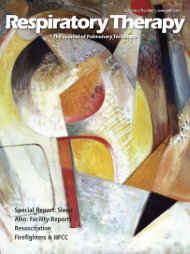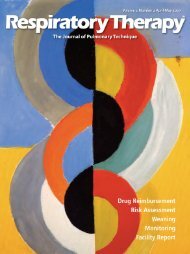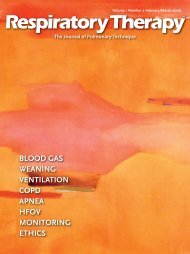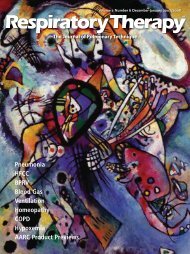RT 02-03 JJ07 main web - Respiratory Therapy Website
RT 02-03 JJ07 main web - Respiratory Therapy Website
RT 02-03 JJ07 main web - Respiratory Therapy Website
Create successful ePaper yourself
Turn your PDF publications into a flip-book with our unique Google optimized e-Paper software.
evolutionary therapy, the VPAP Adapt SV is able to deliver<br />
amazing results and superior patient outcomes where other<br />
therapies have failed.<br />
Please discuss cost-savings/benefits for both purchasers<br />
and patients using your products.<br />
Unlike conventional SDB therapies such as CPAP, the VPAP<br />
Adapt SV device treats central sleep apnea in all its forms to<br />
provide the right therapy the first time. Patients with complex<br />
sleep apnea cannot be adequately treated with CPAP, but the<br />
proven track record of the VPAP Adapt SV ensures a simple and<br />
effective solution for these complex breathing disorders.<br />
Clinicians benefit from this revolutionary device that treats<br />
these patients where other technologies have failed. The default<br />
settings on the VPAP Adapt SV are suitable for most patients, so<br />
titrating patients is a simple process for sleep lab technicians.<br />
Most importantly, patients benefit from the effective therapy<br />
that the VPAP Adapt SV delivers. As a result their lives are<br />
improved and they can finally get a good night’s sleep. Visit<br />
resmed.com/SimplyAmazing for further information.<br />
Clevemed<br />
Hani Kayyali<br />
Hani Kayyali is President of CleveMed (Cleveland Medical).<br />
What products do you offer for diagnostics?<br />
Crystal Monitor 20-S and Crystal Monitor 20-B are small,<br />
handheld, 14-channel wireless PSG systems that come with two<br />
different data transmission frequencies. With different frequency<br />
options, sleep labs are able to choose the system best suited for<br />
their environment.<br />
Sapphire PSG is a 22-channel wireless PSG system that offers<br />
full PSG diagnostic capabilities in a small and flexible package.<br />
With multiple wireless data transmission frequency options built<br />
into the hardware and software, the Sapphire PSG offers the<br />
flexibility to be used in hospitals, even in critical care areas, as<br />
well as sleep labs, patient homes and international markets.<br />
SleepScout is a small and compact 9-channel screener for sleepdisordered<br />
breathing or restless leg syndrome. Unlike other<br />
sleep screeners, SleepScout is designed with an onboard<br />
wireless data transmitter that can communicate with a PDA or<br />
laptop computer to confirm proper electrode placement. In<br />
addition to the 7 dedicated channels, SleepScout’s flexible<br />
design offers an additional 2 channels that are fully<br />
programmable in which the technician can acquire any<br />
combination of EEG, EOG, ECG and EMG. Data is stored on a<br />
removable memory card for later retrieval. Each system<br />
includes a sophisticated PSG software package and a flexible,<br />
wireless design that allows for attended, virtually attended, and<br />
unattended studies in almost any setting.<br />
What are the latest trends for such products?<br />
The latest trend in diagnostic products is Wireless. Sleep<br />
disorders, especially sleep disordered breathing (SDB), is no<br />
longer an isolated disorder. It is strongly linked and can impact<br />
the management of care of many life threatening diseases like<br />
cardiovascular and pulmonary diseases. Undiagnosed SDB can<br />
also complicate surgeries and can play a role in caring for the<br />
elderly. It is not reasonable to ask all these patients to come to<br />
the sleep lab for diagnosis; labs are overcrowded as it is. In<br />
order to properly diagnose these patients, we must go to them,<br />
whether it is in the hospital room, surgical suite, nursing home<br />
or their own home. This is where wireless comes in. Just like<br />
the way cell phones changed the communication industry,<br />
wireless PSG will change the sleep diagnosis market by quickly<br />
reaching those patients wherever they are and when they most<br />
need it.<br />
What products do you offer for therapy? What are the<br />
latest trends for such products?<br />
We are currently working on a new CPAP device that has vastly<br />
improved diagnostic capability. We can not say much about our<br />
new technology at this point because it is confidential, but we<br />
believe that new applications will fuel CPAP’s growth. Whether<br />
using CPAP postoperatively to reduce surgical complications, or<br />
whether it monitors subtle and serious changes in the patient’s<br />
disease state over time, CPAP technology must step up to meet<br />
these new needs. One example is Complex Sleep Apnea.<br />
Research is finding that up to 15% of the current CPAP users<br />
may in fact be developing Central Sleep Apnea, which will likely<br />
need different treatment. Current CPAP machines can not<br />
detect those changes, and therefore cannot properly report on<br />
the progress of potentially thousands of patients! Who knows<br />
what new disease states we will find in the near future that<br />
demand careful therapy management. Therefore, future<br />
therapeutic products are those that are smarter with capabilities<br />
to offer effective therapy for the complicated patient who is<br />
becoming the norm and not the exception. As importantly,<br />
these technologies must be developed for home use since<br />
pressures to shift diagnosis and treatment from the lab to the<br />
home continue to mount.<br />
How has technology changed in the past several years?<br />
While advancements in oral appliance technologies and<br />
surgeries have improved, CPAP continues to be the most<br />
effective and popular sleep apnea therapy. However, as<br />
mentioned earlier, traditional CPAP is no longer sufficient. I<br />
believe the traditional CPAP market will slowly but surely be<br />
replaced with smarter CPAP technologies. Indeed, several<br />
benchmark studies have shown improvement in Auto-Adjust<br />
CPAP technologies over the past couple of years. There is a lot<br />
more work to do in this area, especially since SDB is a<br />
relatively young disease with new clinical manifestations and<br />
comorbidities that continue to be uncovered regularly.<br />
Please discuss your company’s current R&D efforts.<br />
CleveMed’s R&D efforts have been focused on finding new and<br />
innovative technologies for both the diagnosis and treatment of<br />
sleep disorders. Our current product offerings include the<br />
Crystal Monitor 20-S and Crystal Monitor 20-B, complete<br />
wireless 14 channel PSG systems and SleepScout, a 9 channel<br />
sleep disorders screener. To help physicians find the system<br />
best suited for their environment, CleveMed will be releasing<br />
Sapphire, a 22 channel wireless PSG system, in June of this year.<br />
All four systems include Crystal PSG software, a sophisticated<br />
software package for data acquisition, scoring and reporting.<br />
Later this year, the software will be expanded to include scoring<br />
for neonatal sleep studies. CleveMed’s R&D for sleep disorders<br />
diagnosis has been focused on expanding the reach of the sleep<br />
lab to include other settings such as hospital patient rooms,<br />
outpatient pre-surgical centers, nursing homes, “sleep hotels”<br />
and patients’ homes. In doing so, physicians and technologists<br />
who need flexibility because of different service contracts<br />
benefit from our systems, as do patients that are better suited to<br />
<strong>Respiratory</strong> <strong>Therapy</strong> Vol. 2 No. 3 � June-July 2007 53











